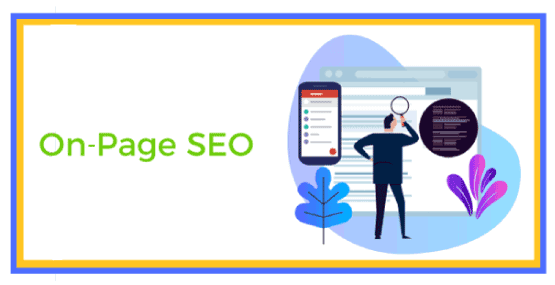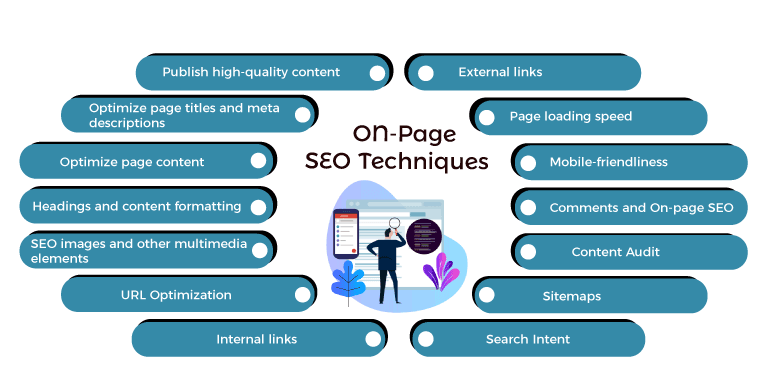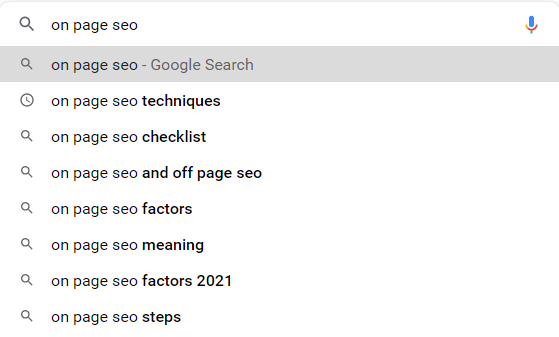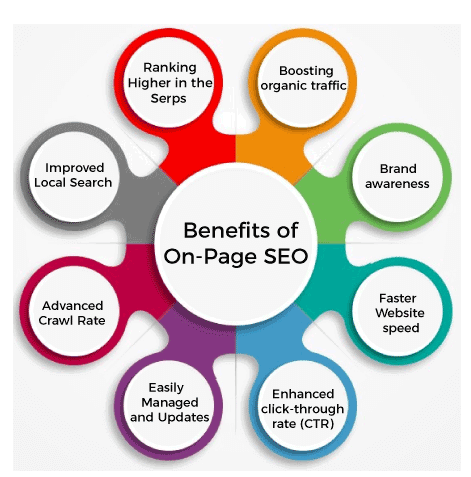On-Page SEO TechniqueWhat is On-Page SEO?On-Page SEO is also known as On-site SEO. On-Page SEO refers to the process of optimizing individual web pages in order to improve their search engine rankings. On-Page SEO is multi-faceted and extends beyond content, and includes other features such as schemas and meta tags. On-Page SEO intercepts with technical SEO and Off-Page SEO. While all three processes work together to give you the best possible result, On-Page SEO is responsible for optimizing the content and layout of a web page. 
On-Page SEO contains:
On-Page SEO Techniques
The following are the On-Page SEO Techniques: 1. Publish High-Quality ContentKeep the following points in mind when it comes to SEO: A website with excellent content can work great with or without SEO. A website with poor content will not survive with or without SEO. A website with great content can become much better with SEO! So, what makes a piece of content high-quality? High-quality content has the following characteristics:
2. Optimize Page Titles and Meta DescriptionsThis is SEO 101, but it's critical for On-page SEO. As search engines 'read' your pages, among other things, they look at the page's description and title. They do this because they need to know what the page is about and then based on the other factors (off-page SEO, domain authority, competition, etc.). They can make your page (for different keywords). The index will rank in their position. The following are some relevant page title optimization tips:
3. Optimize Page ContentOptimize page content is another On-Page SEO Technique. On-page SEO includes content optimization, which involves optimizing the actual content for the target keywords. Before publishing any type of content such as images, text, video, or, audio the first step is to conduct keyword research. This is important to determine what search terms users enter into the search box and generate content that meets their needs. After choosing your target keyword, make a list of similar keywords (also known as LSI keywords) and longtail keywords to use in your headings, page content, description and titles. What is the reason for this? Because with the introduction of Rank Brain, Google search algorithms have become more sophisticated, and they are now searching for subject relevancy and keyword relevancy in content. It means you can use LSI keywords in your content to make it more applicable to large topics. There are many methods for determining which keywords Google consider to be important to your target keywords. According to Google, the simplest and quickest method is to use one of Google's three features: People also query for related searches. Google Suggest When we begin typing a query in Google search, we are given a list of phrases to use in our search. These are excellent keywords candidates to mention in your keywords. 
People Also Ask When you press search, Google displays the results, including a section called "People also ask" among them. These are excellent candidates that you can use in your subheadings. 
Related Searches At the bottom of the search results, Google displays you a list of related searches. 
All you need to do is use any of the words mentioned above in your content (without doing keyword stuffing). 4. Headings and Content FormattingA page must be formatted correctly. Consider it as a report with the main heading (h1) and subheadings (h2, h3). The h1 tag Only one H1 tag is required for each page. If you are using WordPress, the page's title is automatically wrapped in H1 tags. You may use the same title and <h1> Tag or give the heading a different title. Don't forget that search engines show in the results what they find in the title tag, not the h1 tag. The following are some important points that you have to keep in mind when it comes to the other heading (h2, h3);
Content Formatting Make sure your text is readable before slapping it on a tab:
5. Images and Other Multimedia ElementsFor presentation purposes, images are crucial. With the help of this, you can make your page more interesting and easier to read. The main issues with pictures are that search engines do not understand them and slow down page load times. Best Practices for SEO Optimizing Images
6. URL OptimizationIt's essential to optimize your URLs for maximum SEO. It is divided into two sections. The first section is the URL optimization, and the second is the URL structure. The permanent link is also called a slug, which is the unique URL of every page. 
The length of the good URL must be less than 255 characters; use hyphens in order to distinguish the different parts. An SEO friendly URL is short, descriptive and contains your target keyword, like the page title. 7. Internal LinksLinking to pages within your site is very crucial for SEO due to the following reasons:
Best Practice for Internal Linking:
8. External LinksAn external link is a link that leads to a page on a different domain than your own. For the site which links out, it is an external link, and for the website which receives the link, it's a backlink. We all know how important backlinks are for SEO, but what about external links? External links to relevant pages assist Google in determining the subject of your page. It also tells Google that your page is a reliable source of information. Using external links in your content won't help you with SEO directly because it is not a ranking aspect, but it can support you indirectly. External links can be used to connect to other websites, and you can notify them via email. Webmasters would appreciate it if you linked to them, and it's a perfect way to begin a conversation. You can slowly build this relationship and ultimately get backlinks to your website as various webmasters will be more likely to return the favor. Let's take a quick look at the best practices for adding external links to your content.
9. Page Loading SpeedGoogle is spending a lot of money to make the web faster. In each Google I/O, someone will mention the importance of speed and their willingness to have the fastest websites in their index. They also officially incorporated speed as one of the recognized ranking variables to 'force' website owners to consider it. So, you know for sure that website speed matters when it comes to SEO and ranking. Your role as a webmaster is to ensure that your site loads as quickly as possible by following Google's recommendations. Fast-loading sites are beneficial only for SEO but also for customer retention and conversations. 10. Mobile FriendlinessAbout 60% of searches in Google are now coming from mobile devices. This means that if your website is not mobile-friendly, you are already losing half of the potential traffic. What should you do? Make sure your website is mobile-friendly as a first move. Check your website's mobile-friendliness with Google's tool and address any issues that arise. Then take it a step further and test your site on mobile, like a real user would do and ensure everything is shown appropriately, together with your CTA button. Generally, mobile-friendliness is not an issue for websites with a responsive design. 11. Comments and On-Page SEOMany people assume that blog comments have become obsolete with the advent of social media, but this is incorrect. Comments on blogs are still relevant. According to Gary Illyes of Google, it's a sign that people like your content and engage with the page, which can help your SEO. Users would most likely read previous comments before adding a new one, which is another way to maximize the amount of time they spend on the page and your site. You have to follow these simple rule s to make the best use of comments:
12. Content AuditContent audit means a list of all the content properties on your website. When you audit your content, consider both quantitative as well as qualitative factors. With the help of the audit, you can determine which content assets have to be repurposed, retained and deleted from the website. To grade each page, you have to be considered a mix of quantitative and the qualitative parameters.
In order to audit more quickly, keep the assessment criteria simple. This exercise should be repeated every 3-6 months to ensure that the content strategy is still being refined. 13. SitemapsWebmasters may use sitemaps to let them know which pages on their site are crawlable. Sitemap means an XML file that contains a list of URLs as well as additional site metadata. Sitemaps assist web crawlers in locating and crawling all the pages on our site. They often give search engine details about when a page was last updated and how often it was updated. 14.Search IntentOver time, Google has improved its ability to determine what a user is searching for without relying solely on traditional SEO factors. Search intent has become a more important factor, frequently outweighing traditional SEO elements such as title, links, heading, and other SEO fundamentals. Traditionally search intent was classified into the following categories:
However, as time went on, search engines found that this classification was too vague and overlapping. For example, if anyone types 'amazon laptop deals' you could classify 'amazon laptop deals' as both transactional (trying to purchase a laptop) and navigational (trying to reach amazon) intent. You must know the intent and search engine to ensure that your site ranks good for search terms. Search intent is classified into the following categories by content harmony.
Benefits of On-Page SEO
The following are the benefit of On-Page SEO: 1. Ranking Higher in the SerpsMaking unique and good quality content and then enhancing them using on-page SEO techniques can help list your web page higher in the SERPs (Search Engine Results Pages). 2. Boosting Organic TrafficIt is important to utilize a search engine optimization organization to utilize progresses ranking, crawl rate, and CTR to carry out proficient on-page SEO procedures. In such a manner, you are more likely to draw organic traffic to your website and pages without having to spend money on ads or advertisements. 3. Brand AwarenessHigher rankings and your site's exposure on search engines can significantly upgrade your brand value. The higher and more your content and pages are ranking in Google and the other search engines, the more brand value it builds. Building your website's brand value will help you market your business and increase sales. 4. Faster Website SpeedWith exceptional HTML coding and different basics of on-page SEO implementation on your website and pages, you achieve higher rankings because of a quicker site loading speed and quality web content, which was made by emphasizing the best SEO strategies. 5. Enhanced Click-Through Rate (CTR)Methodical streamlining and ideal production of Meta titles with Meta portrayals are vital for online site improvement to acquire a superior active clicking factor. It assists with higher positions in web indexes and getting more taps on your posts by site clients. Be cautious about the length and substance of your meta portrayals. Ideal meta portrayal implies the correct length and utilization of your fundamental catchphrases. You should check this meta depiction length apparatus if you need to rank up your page significantly more. 6. Easily Managed and UpdatesIn contrast with off-page, it is simpler and more straightforward to oversee, control, and follow the latest Google calculations and updates by using on-page SEO systems. 7. Advanced Crawl RateThe ultimate objective of a site is to be observed and crawled by the search engines bots. They should be indexed and rank among different pages that provide similar products and services like yours. Compelling On-page SEO can help site analytic tools and crawlers comprehend what your page is offering and what context it should reflect and rank the search engine result pages. 8. Improved Local SearchIt is the most effective strategy for increasing local exposure and scope. For example, SEO Ipswich takes a special approach to local SEO. As a result, they generate many leads and sales for local businesses that do not have an online presence.
Next Topic#
|
 For Videos Join Our Youtube Channel: Join Now
For Videos Join Our Youtube Channel: Join Now
Feedback
- Send your Feedback to [email protected]
Help Others, Please Share









